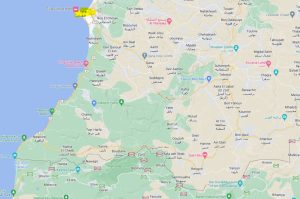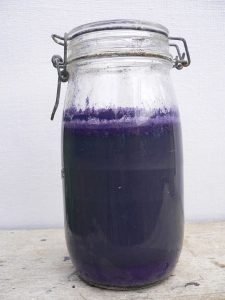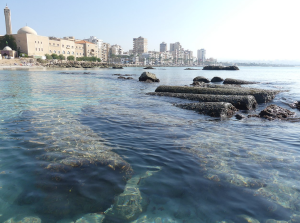Last time we looked into the various values of coins that are mentioned in the first Mishnah in Kiddushin. The coin denominations derive largely from the Roman system but here on page 11 we have a new piece of the coin puzzle: where the coins are minted:
“Rav Yehuda says that Rav Asi says: Every sum of money mentioned in the Torah is Tyrian coinage” (Kiddushin 11a)
Where is Tyre and why are its coins considered the “gold standard” for Torah requirements?
Tyre is about twenty-five kilometers north of the Israeli border on the coast, in the country of Lebanon:

While today we think of Lebanon mostly for the terrible civil wars it has suffered and for its domination by the terrorist Hezbollah group, Lebanon had a storied ancient past. Its residents were called the Phoenicians. The Phoenicians were ethnically related to the Canaanites, the indigenous inhabitants of the land of Israel. They worshipped the same gods and had the same way of life. While many Canaanites were farmers, the word Caananite actually means a merchant or trader, as in this famous phrase from the poem A Woman of Valor:
סָדִ֣ין עָ֭שְׂתָה וַתִּמְכֹּ֑ר וַ֝חֲג֗וֹר נָתְנָ֥ה לַֽכְּנַעֲנִֽי׃”
She makes cloth and sells it, And offers a girdle to the Caananite.” (Proverbs 31:24)
The Phoenicians were famous for their trading abilities. Unlike other powers, they did not expand their reach through military might but through economic prowess. The book of Ezekiel (chapter 27) has a long passage devoted to the people of Tyre and their trafficking in all sorts of goods. The Phoenicians used their trade empire to expand down the coast of the land of Israel and across the Mediterranean to North Africa, where they founded the city of Carthage.
The Bible does not use the term “Phoenician.” The people of Lebanon are referred to by their chief cities, Tyre and Sidon, צור וצידון. Because of their economic power, they were good allies to have. King Solomon befriended Hiram king of Tyre and the latter sent him cedars to build the Temple, as well as skilled workers. About a century later, another king also made an alliance with the Phoenicians but his was more dangerous. King Ahab of Israel married Jezebel, princess of Sidon, and presumably reaped great economic benefits from the union. But the princess came with a catch – the Baal worship that was rampant in her homeland. Jezebel greatly increased idol worship in the kingdom of Israel, and brought a cavalier attitude towards justice that she must have witnessed in her father’s palace, as we see in the terrible story about Navot and his vineyard (Kings I:21)
The Phoenicians settled on Israel’s coast. We have evidence of them in Ashkelon, Akko and other coastal towns, including a dog cemetery in Ashkelon. Interestingly, some also made their way inland. In Bet Guvrin, about thirty kilometers east of Ashkelon, there is a 3rd century burial cave with an inscription honoring Appollophanes, chief of the Sidonians in Maresha. The inscription is in Greek and the images in the richly decorated burial cave are Greek mythological figures alongside animals, a clear sign that the Phoenicians fell under the Hellenizing spell like most of the ancient Near East.
Besides their economic abilities, the Phonecians were also well known for two other things: their dyeing industry and their mint. The name Phoenicia comes from the Greek word for purple, and Phoenicia was the land of the purple. Color was a very valuable commodity in the ancient world and the most sought after color was purple, the color of kings. The Phoenicians collected the murex snails from their coastline and knew the secret of making the valuable dye that they then sold all over the ancient world. The same snails were also used for the techelet dye, the beautiful blue that colors one fringe of the tzitzit, Jewish ritual fringes. The secret of making the dye blue rather than purple lies with chemistry but the method was lost for many years and has only recently been rediscovered. Did the Phoenicians teach the Jews how to make techelet?

Kanold, CC BY 3.0 <https://creativecommons.org/licenses/by/3.0>, via Wikimedia Commons
The other significant Phoenician product was coins and here we find the answer to the question on our daf. The mint in Tyre was considered more reliable than other mints (many mints “watered down” their coins with baser metals) and was what people used throughout the first century BCE to the end of the first century CE. The rabbis decreed that the half shekel coin that must be brought yearly to the Temple could only be made from Tyrian silver: שקל צורי. Some of these very distinctive coins have been found in archaeological sites today.
The Tyrian shekel had an image of a Roman eagle on one side and of a local god, Melqart, on the other. Melqart was a Canaanite god considered to be the local god of Tyre. He was also associated with the Greek hero Hercules. The coin had a Greek inscription that stated “Tyre the holy and the [city of] refuge.” Despite these pagan motifs, the coin was widely used in Judea and has been found in Jerusalem as well as in other places around Israel.

Creative Commons Zero, Public Domain Dedication
The most impressive hoard of Tyrian shekels was discovered in the Druze town of Ussafiya in the Carmel mountain. In 1960 a resident of the town found a container with over 4600 silver coins in it, the overwhelming majority were Tyrian shekels, most minted in the mid-first century CE. While no one knows how they ended up there, there is speculation that they were collected from surrounding towns to be brought to the Temple and then some disaster intervened and they were buried. Perhaps the messengers heard about the Great Revolt and thought it unwise to bring their treasure to war-torn Jerusalem.
From the coast of Lebanon to the Temple in Jerusalem, the Phonecians were a key element in Judean worship and trade.

RomanDeckert, CC BY-SA 4.0 <https://creativecommons.org/licenses/by-sa/4.0>, via Wikimedia Commons










